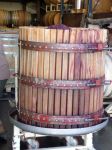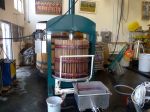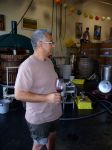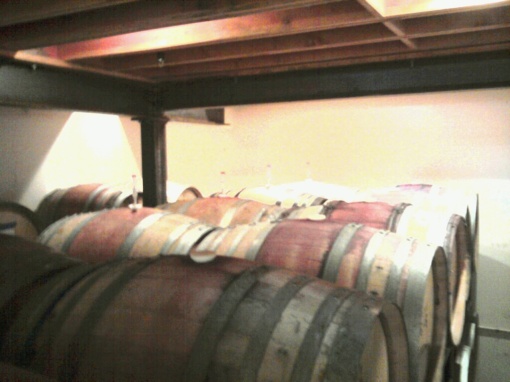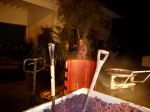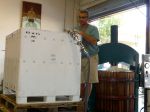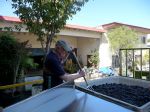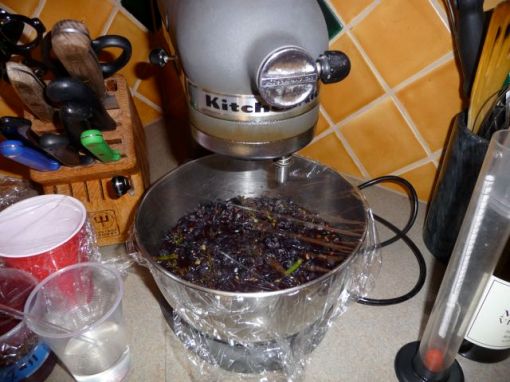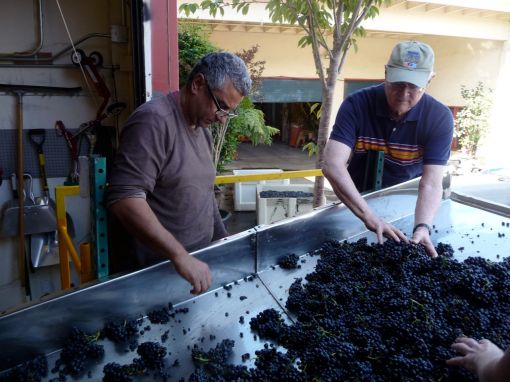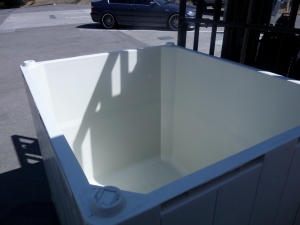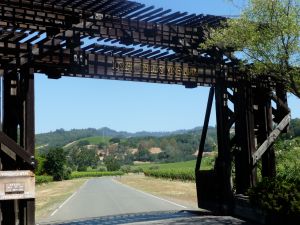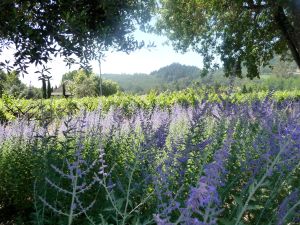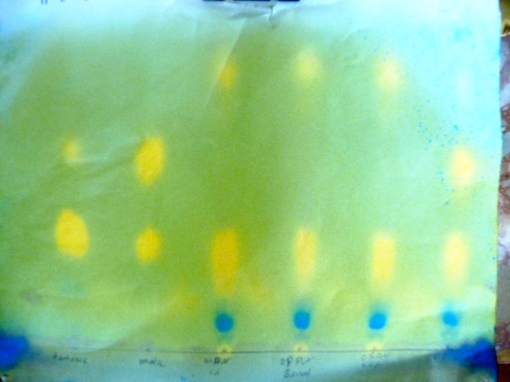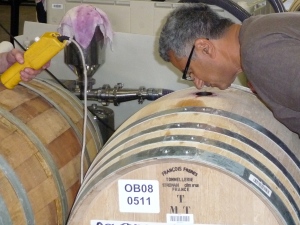The 2012 harvest has come to an end…the fruit picked under stellar conditions, the fermentations completed without a hitch and the wine barreled down for the winter. Nearly everyone is celebrating Northern California’s “epic” harvest, the biggest in years, including us and we’ve shared some photos of here:
fermentation
October 9, 2012
Harvest 2012 Photos
Posted by stompinggirl under fermentation, pinot noir, Pressing, Russian River | Tags: Pressing, Stomping Girl Wines |Leave a Comment
October 16, 2010
Pressing the 2010 Beresini Pinot
Posted by stompinggirl under fermentation, harvest, Pressing, winemaking | Tags: Grape harvest, Pressing |Leave a Comment
After a 4 day cold soak and 10 day fermentation (14 days total on the skins,) we pressed the Beresini Vineyard Pinot Noir. We did one bin native yeast fermentation and one we inoculated with RC212. We were so happy with the native yeast results that we decided to go all the way native with our last lot of Pinot–Corona Creek. Early next week we’ll press the Lauterbach Vineyard and Corona Creek Vineyard Pinots.
October 15, 2009
Harvest Photos
Posted by stompinggirl under crush, fermentation, harvest | Tags: Grape harvest, pinot noir, Pressing, punch downs |[4] Comments
We at Stomping Girl have just gotten through harvest and can finally take a bit of a breather. Now, mind you, “harvest” means much more than just harvest. The term refers to everything from harvesting the grapes to crushing the grapes to pressing the wine. It takes about 2 weeks to take one of our Pinots from harvest to press and we had three harvests this year. Check out some of our photos taken during these last several weeks during Stomping Girl’s ’09 harvest.
- 14. enjoy well deserved meal
- 13. clean up
- 12. …into the barrels
- 11. press rest of wine
- 10. siphon free run wine
- 9. punchdown grapes with tool
- 8. punchdown grapes with feet
- 7. cold soak with dry ice
- 6. destem the grapes
- 5. sort grapes
- 4. pitchfork grapes onto sorting table
- 3. drive grapes to winery
- 2. harvest grapes
- 1. wake up early and drive to vineyard
September 30, 2009
Everywhere fermenting grapes
Posted by stompinggirl under fermentation, home wine cellars, winemaking | Tags: fermentation, winemaking |Leave a Comment
OK, this time of year I expect to find multiple vessels containing fermenting grapes at the winery and even downstairs in our home wine cellar. But I did not expect to find this in my kitchen this morning. It is a small sample of our Sonoma Coast, Corona Creek Vineyard, Pinot fermenting naturally with native yeast…naturally in the mixing bowl of my Kitchen Aid. I’m afraid to check the bath tub.
September 15, 2009
Harvesting our Beresini Pinot Noir
Posted by stompinggirl under Carneros, crush, fermentation, harvest, Local Wineries, pinot noir, vineyards, winemakingLeave a Comment
We had our first harvest this week for 2009–our Beresini Vineyard Pinot Noir. The fruit, beautiful, tasty and at perfect Brix (sugar) and pH levels, was telling us it was time to pick. Those of you in the Bay Area know that Mother Nature was not in agreement, however. She handed us some rare and unexpected thunder showers just before our planned harvest date. Luckily Beresini is in the Carneros appellation just north of most of the weekend showers that hit our area and with a minor date adjustment, we were able to pick, sort and de-stem the fruit without a problem and under sunny skies. Uzi was in the vineyard to help harvest and take the video and then met us at the winery with the grapes.
June 22, 2009
Bins and Barrel Racks in Napa
Posted by stompinggirl under crush, fermentation, Wine Tasting, winemaking | Tags: commercial winemaking, Napa, vineyards, Wine Tasting |Leave a Comment
We are increasing production this coming year, 2009, and purchasing some additional equipment–barrel racks, macro bins and barrels. Uzi found some lightly used barrel racks and macro bins from a contact at Joseph Phelps Vineyards in Napa and made arrangements for me to inspect the equipment in person before purchase.
My trip to Joseph Phelps reminded me why Napa is such a sought after destination. Uzi and I tend to visit Sonoma or other wine regions more frequently than Napa. A drive on Hwy 29 is like a trip down the wine aisle at a large grocery store–Beringer, Mondavi, Sutter Home, Freemark Abbey. There are countless B&Bs, Auberges, tour buses and gift shops. Despite all that, the scenery this time of year in Napa Valley is spectacular. The grape vines are lush, full and green. There are mountains, country lanes and weathered barns amid the vineyards. And once you get off the beaten path you can find less frequented, more intimate wineries.
Unfortunately my business in Napa Valley this time did not include wine tasting or luxury accomodations. I was there to inspect winery equipment–which passed the test–and camp with some friends. Our big splurge was Taylor’s Automatic Refresher in St. Helena where you can enjoy Calera Pinot Noir in a proper glass with your cheeseburger and fries. A fine way by me to enjoy Napa Valley.
March 18, 2009
Sugar High
Posted by Uzi under fermentation, harvest, vineyards, winemaking, wineriesLeave a Comment
 Ever wonder what it is in sugar that makes our kids run around like crazy? Or why we like it in all forms? Well, I don’t have the answers here, sorry. But, I do have an opinion about high sugars in grapes. Maybe they are somehow related.
Ever wonder what it is in sugar that makes our kids run around like crazy? Or why we like it in all forms? Well, I don’t have the answers here, sorry. But, I do have an opinion about high sugars in grapes. Maybe they are somehow related.
I just came back from a seminar put on by the Napa Valley Grape Growers association. The main topic was different, but the high sugar topic was top of mind and kept on creeping into the discussion.
In the last few years, there seems to be a preference for higher alcohol levels in red wines. There seems to be a market preference, which might be driven by a reviewer’s preference and in some cases this leads winemakers to cater to that preference. This means picking grapes later to allow the sugar level in the grapes to increase relative to the overall weight of the grapes (measured in Brix). The phenomena is called Letting it Hang. An increase in Brix level ultimately results in an increase in alcohol level in the wine. If you noticed, I am being very careful with my words. There is more and more evidence that the increase in sugar level is not because the vine is producing more sugar but because the clusters are dehydrating, therefore increasing the ratio of sugar to the rest of the grape cluster weight. This is a trick the Italians play with their intoxicating Amarone, except they dehydrate the grapes after they pick them.
Why does it matter? Two main reasons:
- As the grapes shrink due to dehydration, the growers that get paid by the ton get short changed–that’s most of them.
- Winemakers that pick very late with high sugar levels risk picking grapes with low acids and high PH. Resulting in either an unbalanced wine, or perhaps worse–a wine that has to be manipulated to bring it back into balance.
Why do I think it should matter to wine drinkers? well, at least in my opinion, high alcohol wines typically result in heavy, full body, over the top, prune flavors in the wine. None of the subtle elegance that a classic food friendly wine can and should provide. My taste buds, my preference, your opinion may vary.
This article, in the New York times by Eric Asimov, which was forwarded to me by multiple friends, does a much better job describing the style of wine I am talking about. It also includes a list of wineries producing some of these classically elegant wines.
Back to my post, just like sugar, high alcohol wines, can bring me crashing down 30 minutes later and wanting for a more balanced wine.
November 11, 2008
Malo is done!
Posted by Uzi under fermentation, winemaking | Tags: fermentation, malolactic, wine, winemaking |Leave a Comment
This weekend we performed the chromotagraphy tests on our Las Brisas Pinot Noir and Pinot Noir rose. I am happy to report that the Malo-lactic, or ‘Malo’ conversion is complete–right on schedule. Just like in the previous five years, by the time the first week of November rolls around, the little bugs have done their job. Basically wine contains a few different kinds of acids, Tartaric is one and Malic another. There are others but not in high enough quantities to be noticed. During malo conversion (also referred to as Secondary Fermentation) Malolactic bacteria eat away at the Malic acid and covert it to Lactic acid and Carbon Dioxide. Being about half as strong as Malic acid, Lactic acid is softer on the pallet. The total effect is reduction in total acidity and a rounder softer, mouth feel. For a real technical description see here. In my opinion it has been overdone in many California Chardonnays and I do not like it in that varietal. However, many red wines benefit and are enhanced by it, so we pursue it with our Pinot. In addition to the reduction of acid, it stabilizes wine and should be done before bottling. If you bottle before Malo conversion is complete, it might be triggered spontaneously when the weather warms up. This will put the bugs in motion, only this time while they are enclosed in a bottle. You will end up with ugly deposits, aromas and fizz that could potentially push out corks.
Which gets me back to Chromatography, how do you know when ‘malo’ is done? At the winery we take a sample and send to the lab. A day later we get an email that tells us the Malic acid content in grams per liter. If it is under a certain number, i.e. .09 grams per liter, it is done! Easy.
At home, we get to play Mad Scientist and do our own fun, chromotography test. Ben and I just did one this weekend and the image you see here shows the results.
We dot a special paper with wine samples and reference acids (Tartaric and Malic in this case.) Then we put the paper in a special ‘developer’ liquid for 8 hours and watch the liquid travel up the paper. As it travels up it carries with it the different acids to different levels.
Tartaric is at the bottom third, Malic is in the middle and Lactic is at the top. The acids from the wine sample travels up the paper as well. The test is to observe and see if the wine sample has a spot at the same level as the Malic spot. If it does, Malic conversion did not take place; if the spot is faint, it is only part way done. If there is no spot, Malo is done!
Look at the image again. There are six columns. The spot in the far left column is the Tartaric reference; the second is the Malic reference; the third, fourth and fifth columns are the Pinot Noir samples from three different vessels; the last is our Pinot Noir rose. This means that Malo is done for the three Pinot reds–note there are no yellow spots at the same level as the Malic reference dot (mid way thru the paper hights). The Rose however, did not go thru Malo. This is a good thing because we like Rose more acidic, that’s what makes it more refreshing served chilled on a hot afternoon.
If there are winemaker scientists out there wondering what the light dot above the Tartaric and the light dot below the Malic references are, well, my guess is that it is a bit of contamination from the reference solutions while I was preparing the tests. Unless someone else has a different explanation. I did not see these in previous years. In any case, whether malo conversion took place or not, it makes a nice piece of psychedelic, abstract art to hang on the cellar walls.
October 29, 2008
Last of the 2008 wines are in the barrels!
Posted by Uzi under fermentation, winemaking | Tags: Pressing |Leave a Comment
Monday we pressed the last of our Pinot–this one from Santa Lucia Highland’s Lone Oak Vineyard. This one was easy…
Previous presses at home went on for hours and got us all juicy and ‘winey’ from our wooden basket press squirting, buckets dripping and the occasional kid tripping over and wiping hands all over our pants and shirts. As fun as it is to make wine at home, making wine at the ‘real winery’ is refreshing.
There, forklifts, one-ton bins and giant automatic bladder presses are used. There, the pressing process goes like this:
Step one: forklift one ton fermentation bin into the air; Step two: use siphon and gravity to fill barrels 3/4 full with free run juice; Step three: dump, using forklift, rest of must into the press; Step four: push button to start automatic press.
Best part: the smell of a brand new French Oak barrel both before and after filling it…Promises of heaven on earth.
Also good: tasting the press wine as it comes raining down from the press.
That last part is done in steps as we try to figure out at what point we have enough tannins to go into the already barreled wine. When we reach that point, we stop the press and fill the barrels the rest of the way. Done!
